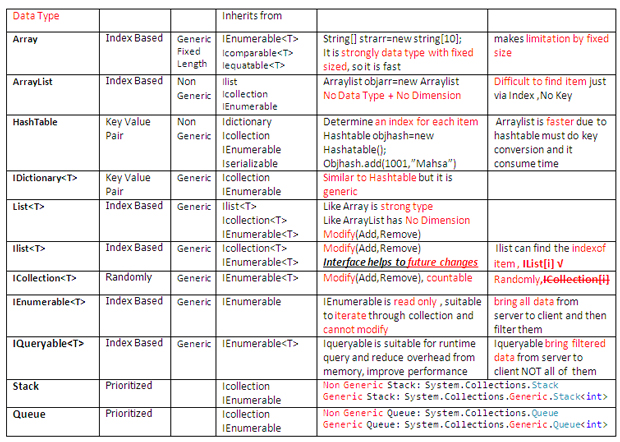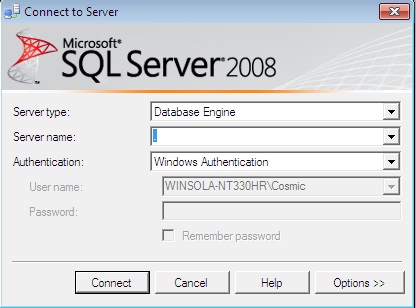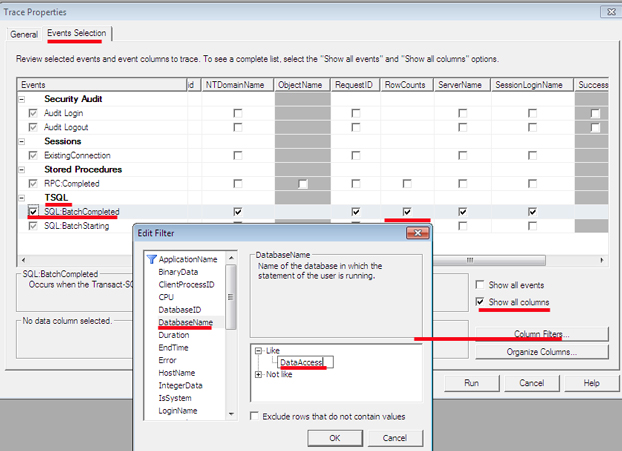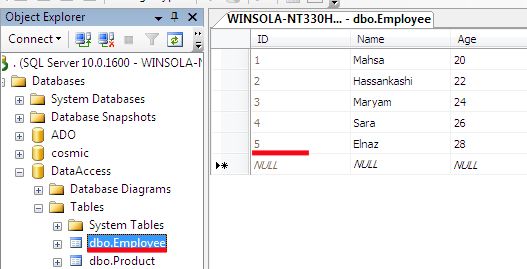Collection
Collection is set of related records. It includes a meaningful unit:
We should select appropriate container to store data temporarily for fetch and modification process.
Appropriate container depends on:
1. Our aim which we want to do on data ( just reading, doing modification such as insert, delete, update )
2. Number of records which should be transferred
Array
1. Fixed Length -> Its size is not flexible. It is determined at instantiation time.
2. Strongly Typed -> Developers determine its type at the instantiation time instead of runtime. This feature makes to run fast at runtime, since it does not need to wait for type definition.
3. Developers use "foreach" keyword to fill and iterate through array.
Fixed Length and Strongly Typed consume less memory, therefore it has good performance.
Hide Copy Code
string[] strArray = new string[10];
for (int i = 0; i < 10; i++)
{
if (strArray[i]==null)
{
strArray[i] = (i+1).ToString();
}
}
this.ListBoxArray.DataSource = null;
this.ListBoxArray.Items.Clear();
this.ListBoxArray.DataSource = strArray;
this.ListBoxArray.DataBind();
ArrayList
1. Arraylist is NOT Fixed Length -> It is possible that data grows. On the one hand it is a good feature whenever developers are not sure about size of arraylist and on the other hand it might take long time for size definition.
2. Arraylist is NOT Strongly Typed -> Whenever developers are not sure about what is exactly type definition for input or output data and they should wait until runtime to appear its type. Its disadvantage is time consuming at the runtime for memory to determine type definition.
3. Developers use "foreach" keyword to fill and iterate through arraylist.
Hide Copy Code
public class Product
{
public Product()
{
}
public Product(string Code, string Name)
{
_Code = Code;
_Name = Name;
}
public string _Code {get; set;}
public string _Name { get; set; }
}
ArrayList can accept string, integer and decimal Simultaneously.
Hide Shrink  Copy Code
Copy Code
System.Collections.ArrayList strArrayList = new System.Collections.ArrayList();
strArrayList.Add("Mahsa"); strArrayList.Add(1); strArrayList.Add(0.89);
this.ListBoxArrayList.DataSource = null;
this.ListBoxArrayList.Items.Clear();
this.ListBoxArrayList.DataSource = strArrayList;
this.ListBoxArrayList.DataBind();
System.Text.StringBuilder str= new System.Text.StringBuilder();
foreach (var item in strArrayList)
{
str.Append(" , "+item);
}
this.lblArrayList.Text = str.ToString();
System.Collections.ArrayList objArrayList = new System.Collections.ArrayList();
objArrayList.Add(new Product("1001", "Chair"));
objArrayList.Add(new Product("1002", "Sofa"));
objArrayList.Add(new Product("1003", "Carpet"));
this.DropDownListArrayListObject.DataSource = null;
this.DropDownListArrayListObject.Items.Clear();
this.DropDownListArrayListObject.DataSource = objArrayList;
Product objTemp = (Product)objArrayList[0];
objArrayList.Remove(objTemp);
this.DropDownListArrayListObject.DataTextField = "_Name";
this.DropDownListArrayListObject.DataValueField = "_Code";
this.DropDownListArrayListObject.DataBind();
this.GridViewArrayListObject.DataSource = objArrayList;
this.GridViewArrayListObject.DataBind();
HashTable
HashTable is another kind of data structure that defines key value for each data section. Therefore finding data is easy just by point out to its key. It is NOT strongly typed and NOT fixed size.
Hide Copy Code
System.Collections.Hashtable objHashTable = new System.Collections.Hashtable();
objHashTable.Add("1001","Chair");
objHashTable.Add("1002", "Sofa");
objHashTable.Add("1003", "Carpet");
this.DropDownListHashTable.DataSource = null;
this.DropDownListHashTable.Items.Clear();
this.DropDownListHashTable.DataSource = objHashTable;
objHashTable.Remove("1002");
this.DropDownListHashTable.DataTextField = "Value";
this.DropDownListHashTable.DataValueField = "Key";
this.DropDownListHashTable.DataBind();
Stack
We have different data structure and stack is one of them. Stack is subset of data structure. Stack is prioritized data structure (such as List is indexed base). Stack defines priority for each item, it means stack behavior force its items to put (push) inside stack prioritized form. So stack put later item on the top of items and this behavior is "defining priority for each item". Therefore whenever you want to insert item, you should add (PUSH) it at the top of the stack and whenever you want to remove (POP) item from stack you should remove it from top of the stack. As you got it, item that comes last one will be selected to POP for first one and its expression in computer science is equal to "Last in First out" == "LIFO".
It is NOT strongly typed and NOT fixed size.
Stack - Push
Hide Copy Code
System.Collections.Stack objStackPush = new System.Collections.Stack();
objStackPush.Push("Mahsa");
objStackPush.Push("Hassankashi");
this.lblPop.Text = "";
this.ListBoxStack.DataSource = objStackPush.ToArray();
this.ListBoxStack.DataBind();
Stack - Pop
Hide Copy Code
System.Collections.Stack objStackPop = new System.Collections.Stack();
objStackPop.Push("Mahsa");
objStackPop.Push("Hassankashi");
this.lblPop.Text = objStackPop.Pop().ToString();
this.ListBoxStack.DataSource = objStackPop.ToArray();
this.ListBoxStack.DataBind();
Queue
Queue is another kind of data structure that defines priority for each item in other form. Therefore whenever you want to insert item, you should add (Enqueue) it at the head of the queue and whenever you want to remove (Dequeue) item from queue you should remove it from bottom of the queue. As you got it, item that comes first one will be selected to Dequeue for first one and its expression in computer science is equal to "First in First out" == "FIFO".
It is NOT strongly typed and NOT fixed size.
Queue - Enqueue
Hide Copy Code
System.Collections.Queue objQueue = new System.Collections.Queue();
objQueue.Enqueue("Mahsa");
objQueue.Enqueue("Hassankashi");
objQueue.Enqueue("Cosmic");
objQueue.Enqueue("Verse");
this.lblQueue.Text = "";
this.ListBoxQueue.DataSource = objQueue.ToArray();
this.ListBoxQueue.DataBind();
Queue - Dequeue
Hide Copy Code
System.Collections.Queue objQueue = new System.Collections.Queue();
objQueue.Enqueue("Mahsa");
objQueue.Enqueue("Hassankashi");
objQueue.Enqueue("Cosmic");
objQueue.Enqueue("Verse");
this.lblQueue.Text=objQueue.Dequeue().ToString();
this.ListBoxQueue.DataSource = objQueue.ToArray();
this.ListBoxQueue.DataBind();
List
Why we need List?
1. List is NOT Fixed Length -> It is possible that data grows. On the one hand it is a good feature whenever developers are not sure about size of arraylist and on the other hand it might take long time for size definition.
2. List is Strongly Typed when it is defined "Generic" -> Whenever developers are sure about what is exactly type definition for input or output data and they do not wait until runtime to appear its type. This feature makes to run fast at runtime, since it does not need to wait for type definition.
3. Developers use "foreach" keyword to fill and iterate through array.
Since List is not Fixed Length makes developers feel flexible to use it, and because of it is Strongly Typed when it is defined "Generic" so our code runs fast at runtime because it does not need to wait for type definition.
Hide Copy Code
//Like Array is Strong Type
//Like ArrayList with No Dimension
System.Collections.Generic.List<string> strList = new List<string>();
strList.Add("Mahsa");
strList.Add("Hassankashi");
strList.Add("Cosmic");
strList.Add("Verse");
this.ListBoxListGeneric.DataSource = strList;
this.ListBoxListGeneric.DataBind();
System.Text.StringBuilder str = new System.Text.StringBuilder();
foreach (var item in strList)
{
str.Append(" , " + item);
}
this.lblList.Text = str.ToString();
IList
Why we need IList? IList is implemented by List, Ilist is an interface and implements methods. Whenever you estimate probability that your code would be changed in future you have to use IList because interface reduces dependency and with the little modification your code runs. Therefore you should observe polymorphism in order to decouple your app and control on adding or removing method that might be changed. Everything else is similar. Whenever we want to change on some operation, so “IList” allow us to do that easily with at least changing in the whole of codes.
Interfaces can not be instantiate, so it should be instantiate from List
Hide Copy Code
System.Collections.Generic.IList<string> strIList = new List<string>();
Difference between Concrete Class and Interface
1. Concrete Class inherits from just ONE class but it Can implements one or MORE than one interfaces
2. You can write inside concrete class full version of your function while you have to define just signature inside the interface.
3. You can define variable and value Inside Concrete Class while you are not allowed to define variable inside interfaces.
4. An Concrete class can have constructor while you are not allowed to define constructor inside interfaces.
5. Abstract class can containe access modifier while intefaces does not.
As I mentioned that how a class cannot be driven from two class it just can be driven from only one class, so whenever you want to drive from two class it is not possible to inherit from two abstract class but it is possible to drive from more than one class by interfaces.
Later in future if developers decide to add some features on their class and inherit it from another class, developers always prefer to use interface of collection so that if you want to change your code and enhance its abilities, choose interfaces.
On the other hand interface keeps your program extensible and Decouple: The classes are independent from each other, so error, exception and failure will happen rarely in future changing code by interfaces.
Polymorphism: When you are using interface you absolutely observe and do polymorphism and oop. It means encapsulate your designer. Interface means a point or a node to join two part to each other it means making low dependency from two part and make a joint section to make flexible change in future.
Hide Copy Code
System.Collections.Generic.IList<string> strIList = new List<string>();
strIList.Add("Mahsa");
strIList.Add("Hassankashi");
strIList.Add("Cosmic");
strIList.Add("Verse");
this.ListBoxListGeneric.DataSource = strIList;
this.ListBoxListGeneric.DataBind();
System.Text.StringBuilder str = new System.Text.StringBuilder();
foreach (var item in strIList)
{
str.Append(" , " + item);
}
this.lblList.Text = str.ToString();
IEnumerable
IEnumerable is suitable just for iterate through collection and you can not modify (Add or Remove) data IEnumerable bring ALL data from server to client then filter them, assume that you have a lot of records so IEnumerable puts overhead on your memory.
Hide Copy Code
System.Collections.Generic.IEnumerable<Employee> empIEnumerable = new List<Employee>
{ new Employee { ID = 1001, Name="Mahsa"},
new Employee { ID = 1002, Name = "Hassankashi" },
new Employee { ID = 1003, Name = "CosmicVerse" },
new Employee { ID = 1004, Name = "Technical" }
};
this.GridViewIEnumerable.DataSource = empIEnumerable;
this.GridViewIEnumerable.DataBind();
System.Text.StringBuilder str = new System.Text.StringBuilder();
foreach (Employee item in empIEnumerable)
{
str.Append(" , " + item.ID +"-"+item.Name);
}
this.lblIEnumerable.Text = str.ToString();
IQueryable
Whenever we encounter to huge data with so many records so we have to reduce overhead from application. IQueryable prepares high performance in such situations (huge data) by filtering data firstly and then sending filtered data to client.
Follow "Entity Framework DatabaseFirst" from
this article for making DBContext
Hide Copy Code
DataAccessEntities ctx = new DataAccessEntities();
var ctx = new DataAccessEntities();
Hide Shrink  Copy Code
Copy Code
IEnumerable<employee> queryIEnumerable = new List<employee>() ;
queryIEnumerable = from m in ctx.Employees select m;
queryIEnumerable = queryIEnumerable.Where(x => x.ID == 1).ToList();
IQueryable<employee> queryIQueryable=null;
queryIQueryable = (from m in ctx.Employees
where m.ID == 1
select m);
this.GridViewIQueryable.DataSource = queryIQueryable.ToList();
this.GridViewIQueryable.DataBind();
</employee></employee></employee>
SQL Profiler:
How to trace your query generates TSQL & How many records will be loaded:
Step 1:
Start -> MS SQL Server 2008 -> Performance Tools -> SQL Server Profiler

Step 2:
SQL Server Profiler -> File -> New Trace
Step 3:
Connect with you user name and password.
Step 4:
General (Tab) -> Use the Template: Standard
Step 5:
Event Selection (Tab) -> Event : TSQL -> Select : SQL-BatchCompleted | Select Show all Columns
Press Column Filter -> Database Name: Like: "DataAccess"
Press Run
Step 6:
Go To MS SQL Server Management Studio -> Count all of records (records=5)
Step 7:
IEnumerable generates:
Hide Copy Code
SELECT
[Extent1].[ID] AS [ID],
[Extent1].[Name] AS [Name],
[Extent1].[Age] AS [Age]
FROM [dbo].[Employee] AS [Extent1]
IQueryable generates:
Hide Copy Code
SELECT
[Extent1].[ID] AS [ID],
[Extent1].[Name] AS [Name],
[Extent1].[Age] AS [Age]
FROM [dbo].[Employee] AS [Extent1]
WHERE 1 = [Extent1].[ID]
ICollection
ICollection inherits from IEnumerable. There is one difference:
you can find IEnumerable[ i ] --> Index Based
you can NOT find ICollection[ i ] --> Not Index Based
Hide Shrink  Copy Code
Copy Code
//IList {indexer and Modify} vs ICollection {randomly and Modify}
//Collection can not be instantiate from ICollection , so it should be instantiate from List
System.Collections.Generic.ICollection<string> strICollection = new List<string>();
strICollection.Add("Mahsa");
strICollection.Add("Hassankashi");
//Countable***
int ICollectionCount=strICollection.Count;
this.ListBoxICollection.DataSource = strICollection;
this.ListBoxICollection.DataBind();
System.Text.StringBuilder str = new System.Text.StringBuilder();
foreach (var item in strICollection)
{
str.Append(" , " + item);
}
this.lblICollection.Text = str.ToString();
//IList***
System.Collections.Generic.IList<Employee> objIList = new List<Employee>();
objIList = (from m in ctx.Employees
select m).ToList();
Employee obj = objIList.Where(i => i.Name == "Sara").FirstOrDefault();
int indexofSara= objIList.IndexOf(obj);
int cIList = objIList.Count;
//ICollection***
System.Collections.Generic.ICollection<Employee> objICollection = new List<Employee>();
objICollection = (from m in ctx.Employees
select m).ToList();
Employee objIC = objICollection.Where(i => i.Name == "Sara").FirstOrDefault();
//You can not get index of object , if you clear comment from below code appears error
// int indexofSaraICollection = objIC.IndexOf(objIC);
int cICollection = objICollection.Count;
Stack Generic
Push:
Hide Copy Code
//Stack is LIFO: Last in First Out
//Here is for Push Stack in Generic
//System.Collections.Stack objStackPush = new System.Collections.Stack();
//Stack<T> can be instantiated from Stack<T>
System.Collections.Generic.Stack<int> objStackPush = new System.Collections.Generic.Stack<int>();
objStackPush.Push(1);
objStackPush.Push(2);
this.lblPopGeneric.Text = "";
this.ListBoxStackGeneric.DataSource = objStackPush.ToArray();
this.ListBoxStackGeneric.DataBind();
Pop:
Hide Copy Code
//Stack is LIFO: Last in First Out
//Here is for Pop Stack in Generic
//System.Collections.Stack objStackPop = new System.Collections.Stack();
//Stack<T> can be instantiated from Stack<T>
System.Collections.Generic.Stack<int> objStackPop = new System.Collections.Generic.Stack<int>();
objStackPop.Push(1);
objStackPop.Push(2);
this.lblPop.Text = objStackPop.Pop().ToString();
this.ListBoxStack.DataSource = objStackPop.ToArray();
this.ListBoxStack.DataBind();
Queue Generic
Enqueue:
Hide Copy Code
//Queue is FIFO: First in First Out
//Here is for Enqueue Queue in Generic
//System.Collections.Queue objQueue = new System.Collections.Queue();
//Queue<T> can be instantiated from Queue<T>
System.Collections.Generic.Queue<int> objQueue = new System.Collections.Generic.Queue<int>();
objQueue.Enqueue(1);
objQueue.Enqueue(2);
this.lblQueue.Text = "";
this.ListBoxQueue.DataSource = objQueue.ToArray();
this.ListBoxQueue.DataBind();
Dequeue:
Hide Copy Code
//Queue is FIFO: First in First Out
//Here is for Dequeue Queue in Generic
//System.Collections.Queue objQueue = new System.Collections.Queue();
//Queue<T> can be instantiated from Queue<T>
System.Collections.Generic.Queue<int> objQueue = new System.Collections.Generic.Queue<int>();
objQueue.Enqueue(1);
objQueue.Enqueue(2);
this.lblQueue.Text = objQueue.Dequeue().ToString();
this.ListBoxQueue.DataSource = objQueue.ToArray();
this.ListBoxQueue.DataBind();
Dictionary and IDictionary
Dictionary is GENERIC while HashTable is not generic : Dictionary<TKey, TValue>, There is a tiny difference between them that if dictionary can not find specific key will throw an exception while HashTable just returns null.
IDictionary is interface and if you estimate big changes in future use IDictionary instead of Dictionary.
Hide Copy Code
System.Collections.Generic.Dictionary<int, string=""> objDictionary = new Dictionary<int, string="">();
objDictionary.Add(1001, "Mahsa");
objDictionary.Add(1002, "Hassankashi");
objDictionary.Add(1003, "Cosmicverse");
string str = objDictionary[1002];
this.ListBoxDictionary.DataSource = objDictionary;
this.ListBoxDictionary.DataBind();</int,></int,>
 Now in the same session (without closing the browser) if a new / second request is initiated then “TempData” will be persisted depending on 4 CONDITIONS:-
Now in the same session (without closing the browser) if a new / second request is initiated then “TempData” will be persisted depending on 4 CONDITIONS:- So let’s discuss these four conditions in more detail ( Do see the below diagram for better understanding ):-
So let’s discuss these four conditions in more detail ( Do see the below diagram for better understanding ):- So if you register these four condition’s in your mind you should not have any confusion’s around TempData
So if you register these four condition’s in your mind you should not have any confusion’s around TempData .
. .
.



















